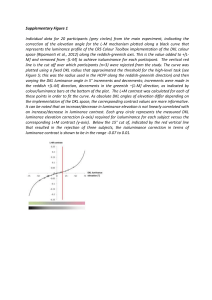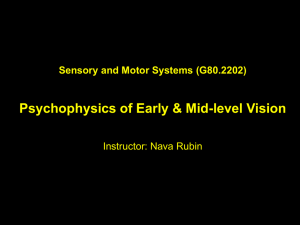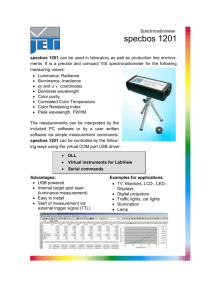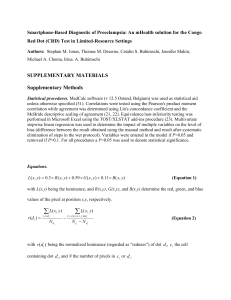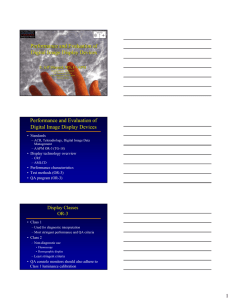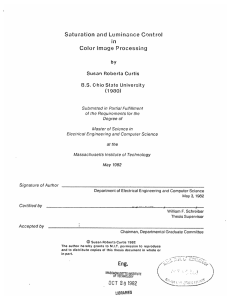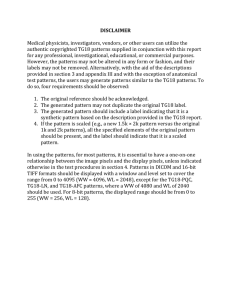PACS monitor evaluation protocol -DRAFT
advertisement
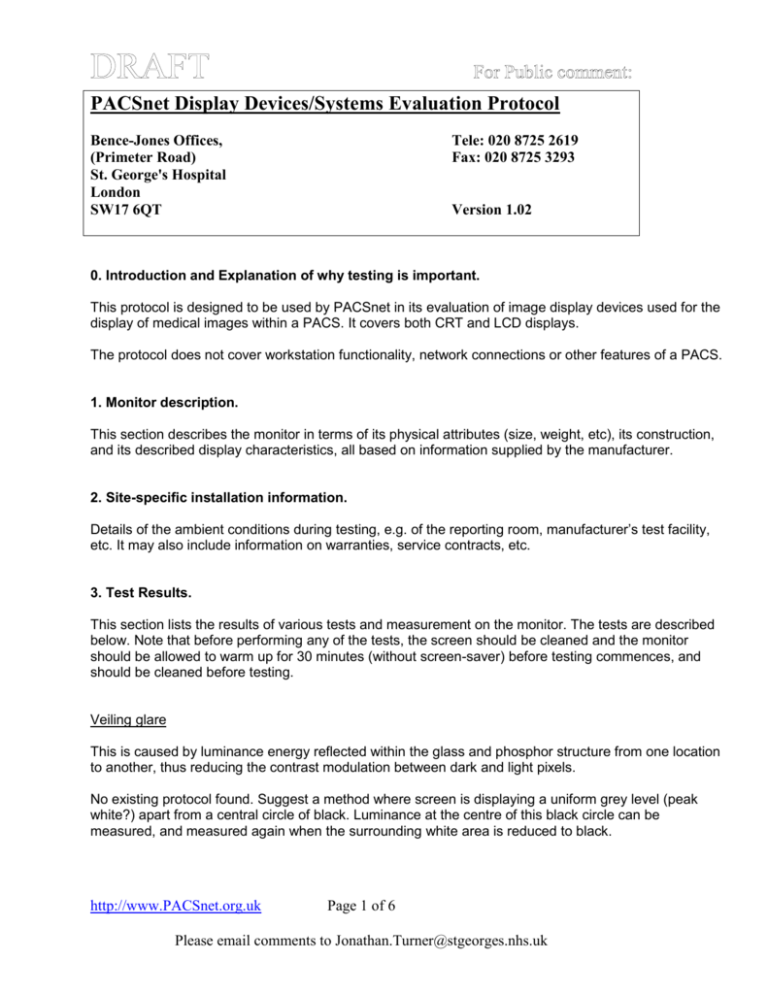
PACSnet Display Devices/Systems Evaluation Protocol Bence-Jones Offices, (Primeter Road) St. George's Hospital London SW17 6QT Tele: 020 8725 2619 Fax: 020 8725 3293 Version 1.02 0. Introduction and Explanation of why testing is important. This protocol is designed to be used by PACSnet in its evaluation of image display devices used for the display of medical images within a PACS. It covers both CRT and LCD displays. The protocol does not cover workstation functionality, network connections or other features of a PACS. 1. Monitor description. This section describes the monitor in terms of its physical attributes (size, weight, etc), its construction, and its described display characteristics, all based on information supplied by the manufacturer. 2. Site-specific installation information. Details of the ambient conditions during testing, e.g. of the reporting room, manufacturer’s test facility, etc. It may also include information on warranties, service contracts, etc. 3. Test Results. This section lists the results of various tests and measurement on the monitor. The tests are described below. Note that before performing any of the tests, the screen should be cleaned and the monitor should be allowed to warm up for 30 minutes (without screen-saver) before testing commences, and should be cleaned before testing. Veiling glare This is caused by luminance energy reflected within the glass and phosphor structure from one location to another, thus reducing the contrast modulation between dark and light pixels. No existing protocol found. Suggest a method where screen is displaying a uniform grey level (peak white?) apart from a central circle of black. Luminance at the centre of this black circle can be measured, and measured again when the surrounding white area is reduced to black. http://www.PACSnet.org.uk Page 1 of 6 Please email comments to Jonathan.Turner@stgeorges.nhs.uk PACS Evaluation Protocols: Evaluation of Display Monitors 0. Introduction. This protocol is designed to be used by PACSnet in its evaluation of image display devices used for the display of medical images within a PACS. It covers both CRT and LCD displays. The protocol does not cover workstation functionality, network connections or other features of a PACS. 1. General monitor description and manufacturer’s specification Physical size of monitor, footprint, any clearances required Weight Removable stand; adjustability of display height and angle (tilt, swivel), other mounting options USB hub Input signal Analogue or digital Signal cable VESA DDC/Ci bi-directional control; sRGB support; VESA VCP support Display Data Channel Command Interface Standard (http://www.vesa.org/dload/summary/sumddcci.htm) Dynamic or static? Colour or black & white display Backlight (for LCD) Required specification of base unit, including video card Any minimum specifications for CPU, memory, hard disk space, OS, etc. Power supply requirements – voltage & frequency Quote manufacturer’s figures. Power consumption Quote manufacturer’s figures. Heat and noise output Quote manufacturer’s figures. Controls available for user adjustment e.g. brightness, contrast, geometry. Ability to disable user adjustment facilities. On-screen manager. http://www.PACSnet.org.uk Page 2 of 6 Please email comments to Jonathan.Turner@stgeorges.nhs.uk Controls available for engineer adjustment Intended use review, diagnosis, text-only, home, etc First year sold, first year sold in UK Territories sold to Currently and ever. Regulatory Approvals CE Mark (ECM Directive, Medical Devices Directive), etc Warranty and/or maintenance contracts available Technical support Response times, on-site engineer Charges for spare parts Time to supply spare parts Self-calibration facilities Bandwidth Refresh rate Scan rates Horizontal synch (range) Vertical synch (range) Display Type Shadow mask, aperture grille Phosphor used for screen Curvature of display surface Portrait or landscape Screen size – quoted, measured Active area – quoted, measured Dot pitch Dot pitch, horizontal dot pitch, vertical dot pitch Deflection angle http://www.PACSnet.org.uk Page 3 of 6 Please email comments to Jonathan.Turner@stgeorges.nhs.uk Bulb transmission Front panel transmission Maximum input video bandwidth Maximum resolution Recommended resolution Test images supplied Screen cleaning recommendations Response time Dot clock Optimum intended viewing angle (for LCD displays) Aperture ratio 2. Site-specific Installation Information Positioning of monitors within rooms User space Reflections, lighting, etc Room lighting: Cornell: “monitor works best in a low-light environment. However, a low-light environment does not equate to a dark room. Viewed in the dark, an on-screen image would appear deficient in contrast.” QA/QC programme in place; tools used. Monitor cleanliness; tidiness of installation (cables, etc) Maintenance contract for this installation DICOM GSDF facility 3. Test Results AAPM TG18 test results. DICOM part 14 Veiling glare (aka “flare” or “surrounding field effect”) Noise in image Instability Convergence http://www.PACSnet.org.uk Page 4 of 6 Please email comments to Jonathan.Turner@stgeorges.nhs.uk Tone scale (e.g. Barten, default) Resolution Flat field uniformity, colour purity Black level, peak white level – levels will depend on the area of the screen illuminated Artefacts Weak internal and external reflections Focussing – test using only one primary colour (if colour monitor) Contrast Brightness Spatial resolution Aliasing Ringing/overshoot streaking Average picture level/grey-level shift Screen regulation Ambient light sensors Radiation levels, emissions certification Power-saving features Contrast ratio Viewing angle Screen reflection Number of colours displayable (colour depth) Gamma Flicker – view an all-white screen using peripheral vision. Important in medical – monitors sit side-byside. Geometric distortion: pincushion, barrel, trapezoidal (“keystone”), orthogonal, tilt, hook (“flagging”), nonlinearity, line pairing, ringing (all from display measurement book). Measurement of warm-up characteristics (“warm-up”) and luminance drift (“aging”) Luminance stability (i.e. changes as greater or lesser areas of screen are white) Number of defective pixels (LCD) Phosphor artefacts (CRT) Aspect ratio Jitter Phosphor persistence (decay) SMPTE test image: constant increase in perceptual brightness (if using workstation software) Test protocol. Let monitor warm up (30 minutes). Set user-accessible adjustments to the settings used in the initial tests. Equipment needed. Photometer “a time constant of approx 100ms corresponds to that of the human eye” Allow to warm up (1-2 minutes usually sufficient) and to stabilise temperature/drying of condensation if necessary (30-60 mins). Illuminance photometer to measure ambient light levels. http://www.PACSnet.org.uk Page 5 of 6 Please email comments to Jonathan.Turner@stgeorges.nhs.uk Luminance probe “A luminance meter of the reflex-viewer type with an accuracy of +/- 10% shall be used to check the consistency of the luminance of the display. The measuring range shall be between 0.1 cd/sq m and 500 cd/sq m. The angle of measurement at the aperture of the meter should be 1 deg and shall not exceed 5 deg.” (BSI 1994) (to measure screen luminance) Cloth tape measure (to measure distances off curved screens and to help with geometry tests)) Straight edge/ruler (to measure distances off screens, and to help with convergence tests and geometry tests) Darkroom with adjustable background lighting (to minimise effect of background illumination and reflections) Oscilloscope (to measure signals from video card, and flicker on screen Detector suitable for measuring flicker Test images Dividers (to help with distance measurements off screen and with geometry tests) Convergence gauge Tests to be performed at the manufacturer’s recommended resolution, as well as at higher and lower resolutions. Test tools: Display Mate: http://www.displaymate.com/intro.html Image Smiths Light source (for measurement of reflectance) Microscope Cleaning materials: cloth, etc Rule Tape measure Film with printed grid Magnifying glass Berlin tests: Background luminance level and luminance range Luminance distribution Spatial and low contrast resolution Image geometry and motion Monitor flickering Artefacts http://www.PACSnet.org.uk Page 6 of 6 Please email comments to Jonathan.Turner@stgeorges.nhs.uk

